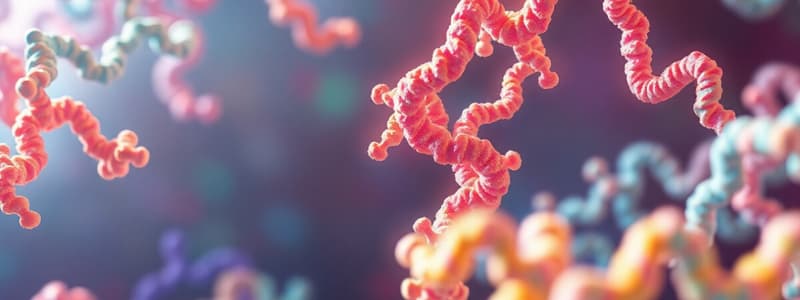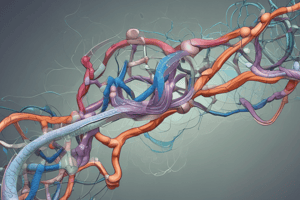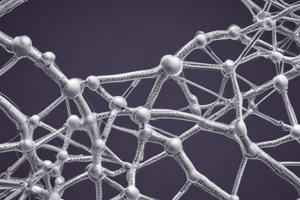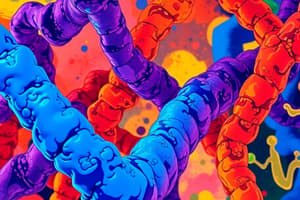Podcast
Questions and Answers
What is the function of fibrous proteins?
What is the function of fibrous proteins?
Fibrous proteins provide support and aid in structure.
Which of the following are examples of fibrous proteins?
Which of the following are examples of fibrous proteins?
- Hemoglobin
- Keratins (correct)
- Elastins (correct)
- Myoglobin
- Collagens (correct)
What is the primary function of collagen molecules?
What is the primary function of collagen molecules?
To provide structural support to tissues.
Collagen is composed of a single polypeptide chain.
Collagen is composed of a single polypeptide chain.
What is the name of the basic unit of collagen?
What is the name of the basic unit of collagen?
Every ______ amino acids in collagen contains glycine.
Every ______ amino acids in collagen contains glycine.
Which amino acid is responsible for the kinks in the collagen helix?
Which amino acid is responsible for the kinks in the collagen helix?
What is the role of hydroxyproline in collagen?
What is the role of hydroxyproline in collagen?
What happens to collagen at temperatures above 40 degrees Celsius?
What happens to collagen at temperatures above 40 degrees Celsius?
What are the two types of modified lysine found in collagen?
What are the two types of modified lysine found in collagen?
What is the main function of cross-linking in collagen fibers?
What is the main function of cross-linking in collagen fibers?
What are the two enzymes involved in the formation of modified lysine?
What are the two enzymes involved in the formation of modified lysine?
What enzyme helps maintain the helical shape of collagen?
What enzyme helps maintain the helical shape of collagen?
What is the name of the disease caused by a deficiency of vitamin C?
What is the name of the disease caused by a deficiency of vitamin C?
Scurvy can lead to spontaneous bleeding of the gums and loose teeth.
Scurvy can lead to spontaneous bleeding of the gums and loose teeth.
What is the main component of elastic fibers?
What is the main component of elastic fibers?
What are the two main types of segments found in elastin?
What are the two main types of segments found in elastin?
Elastin is glycosylated.
Elastin is glycosylated.
What is the name of the cross-link formed between four allysyl side chains and one unaltered lysyl side chain?
What is the name of the cross-link formed between four allysyl side chains and one unaltered lysyl side chain?
What type of bond is formed between cysteine residues in keratin?
What type of bond is formed between cysteine residues in keratin?
Which of the following is NOT a characteristic of keratin?
Which of the following is NOT a characteristic of keratin?
What is the name of the smaller, twisted structure of a-keratin?
What is the name of the smaller, twisted structure of a-keratin?
How many protofibirls combine to form one microfibril?
How many protofibirls combine to form one microfibril?
What process can harden a-keratin in nails?
What process can harden a-keratin in nails?
How do hot or cold water affect the structure of hair?
How do hot or cold water affect the structure of hair?
What is the purpose of a reducing substance in the permanent hair waving process?
What is the purpose of a reducing substance in the permanent hair waving process?
What is used to reform the disulfide cross-links in the permanent hair waving process?
What is used to reform the disulfide cross-links in the permanent hair waving process?
Keratin is used to straighten hair.
Keratin is used to straighten hair.
What is the final product of the polymerization of five protocollagen molecules?
What is the final product of the polymerization of five protocollagen molecules?
What are the types of bonds that strengthen the formation of collagen fibrils?
What are the types of bonds that strengthen the formation of collagen fibrils?
What is the most common type of collagen found in bones and cartilage?
What is the most common type of collagen found in bones and cartilage?
What does the term 'resilient' mean in the context of tissues?
What does the term 'resilient' mean in the context of tissues?
What is the primary feature of a typical collagen molecule?
What is the primary feature of a typical collagen molecule?
The amount of cross-linking in a tissue decreases with age.
The amount of cross-linking in a tissue decreases with age.
What is the major difference between a-keratin and b-keratin?
What is the major difference between a-keratin and b-keratin?
A-keratin is the major protein of hair and fingernails in mammals.
A-keratin is the major protein of hair and fingernails in mammals.
Elastin is present in the extracellular matrix.
Elastin is present in the extracellular matrix.
What are the two main types of molecules that are interwoven in the extracellular matrix?
What are the two main types of molecules that are interwoven in the extracellular matrix?
The arrangement of collagen and elastin fibers in the extracellular matrix affects the tissue's flexibility and resilience.
The arrangement of collagen and elastin fibers in the extracellular matrix affects the tissue's flexibility and resilience.
Flashcards
Fibrous proteins
Fibrous proteins
A type of protein that forms long, thin fibers, providing structural support to tissues. They are characterized by their repetitive secondary structure, which allows for tight packing and the expulsion of water.
Globular proteins
Globular proteins
A type of protein that folds into a compact, globular shape, often with multiple domains. They play diverse roles in biological processes.
Extracellular matrix (ECM)
Extracellular matrix (ECM)
The space between cells filled with a complex network of macromolecules, including proteins and polysaccharides, that provides structural support and regulates cellular communication.
Collagen
Collagen
Signup and view all the flashcards
Tropocollagen
Tropocollagen
Signup and view all the flashcards
Collagen sequence
Collagen sequence
Signup and view all the flashcards
Resilience
Resilience
Signup and view all the flashcards
Flexibility
Flexibility
Signup and view all the flashcards
Elastin
Elastin
Signup and view all the flashcards
Desmosine
Desmosine
Signup and view all the flashcards
Keratin
Keratin
Signup and view all the flashcards
α-keratin
α-keratin
Signup and view all the flashcards
β-keratin
β-keratin
Signup and view all the flashcards
α-keratin dimer
α-keratin dimer
Signup and view all the flashcards
α-keratin microfibril
α-keratin microfibril
Signup and view all the flashcards
α-keratin macrofibril
α-keratin macrofibril
Signup and view all the flashcards
Lysyl hydroxylation
Lysyl hydroxylation
Signup and view all the flashcards
Prolyl hydroxylation
Prolyl hydroxylation
Signup and view all the flashcards
Lysyl oxidation
Lysyl oxidation
Signup and view all the flashcards
Aldol cross-link
Aldol cross-link
Signup and view all the flashcards
Scurvy
Scurvy
Signup and view all the flashcards
Tight packing of collagen
Tight packing of collagen
Signup and view all the flashcards
Collagen fiber formation
Collagen fiber formation
Signup and view all the flashcards
Decreased collagen cross-linking
Decreased collagen cross-linking
Signup and view all the flashcards
Side-by-side packing of collagen fibers
Side-by-side packing of collagen fibers
Signup and view all the flashcards
Temporary wave
Temporary wave
Signup and view all the flashcards
Permanent wave
Permanent wave
Signup and view all the flashcards
Collagen stability
Collagen stability
Signup and view all the flashcards
Collagen denaturation
Collagen denaturation
Signup and view all the flashcards
Keratin amino acid composition
Keratin amino acid composition
Signup and view all the flashcards
Keratin hardening
Keratin hardening
Signup and view all the flashcards
Study Notes
Biochemistry Study Notes
- Sheet number: 20
- Document Year: 2024
- Written by: Duha Alnader & Wedad Mustafa
- Edited by: Reem Ghnemat
- Doctor: Dr. NafezaButarboush
Fibrous Proteins
- Structure-Function Relationship: Fibrous proteins have a strong, solid structure for support. They have a specific type of secondary structure that repeats, allowing for compression and expulsion of water, creating a strong structure. They may also have tertiary and quaternary structures.
- Biological Functions: Enzymes catalyze reactions. Transport molecules include hemoglobin and lipoproteins. Contractile proteins like myosin and actin, along with structural proteins such as collagen and keratin, are involved in movement and structure. Defense proteins include antibodies (i.e. immunoglobulins). Signaling molecules like hormones are involved in communication, along with receptors and toxins (e.g., diphtheria & enterotoxins).
- Types: Fibrous proteins have a uniform secondary structure only. Globular proteins have three-dimensional compact structures.
- Examples: Collagen, elastin, and keratin are fibrous proteins. Myoglobin, hemoglobin, and immunoglobulins are globular proteins.
Extracellular Matrix
- Composition: The extracellular space is filled with an intricate network of macromolecules including proteins and polysaccharides. Collagen is synthesized by cells and released into the extracellular fluid (ECF), providing structural support and tissue straightening.
- Collagen Properties: Collagen accounts for 40% of proteins in the body. It is a family of fibrous proteins with 25 types found in all multicellular animals. Type I collagen is the most common, found in bones and cartilages. Types differ in amino acid composition but share similar structural features. The main function of collagen is to provide structural support in tissues. It is stiff.
- Structure of Collagen: It is a left-handed, triple-stranded, helical protein (tropocollagen). The collagen helix is more extended than the typical α-helix. Every 3 amino acids, a glycine is present. Glycine is the most frequent amino acid in collagen and breaks up the α-helix. Collagen has high amounts of glycine (33%), and proline (13%), and hydroxyproline (9%) & hydroxylysine.
Structure of Collagen
- Properties: Left-handed, triple-stranded, helical protein where three polypeptide chains (a-chains) are wound around one another. Compared to α-helices, collagen helices are more extended (3.3 residues per turn). The basic unit is tropocollagen. Glycine (a breaker of alpha-helices) is present every 3rd amino acid in the sequence. Collagen differs in length (5.4A) and number of amino acids per turn (3.6A) from α-helices.
- Composition: Rich in glycine (33%), proline (13%) and hydroxyproline (9%). The modified form of proline is hydroxyproline, which creates kinks that disrupt the helical structure.
Functional purpose of amino acids:
- Glycine: Packs the three α-chains together to form the final collagen superhelix. It causes the formation of the final triple helical structure.
- Proline: Creates kinks and stabilizes the helical conformation of each α chain.
Hydroxylysine (modified Lysine)
- Lysine can form an aldehyde, or remain as is.
- Hydroxylysine acts as an attachment site for polysaccharides, making the polypeptide chain a glycoprotein
- Two enzymes hydroxylase and oxidase are involved in forming modified forms (crosslinks) of lysine.
Oxidation of lysine
- Some lysines are oxidized to aldehyde (allysine)
- Covalent aldol linkages form between hydroxylysines or other modified lysines creating covalent bonds between polypeptide chains.
Function of Cross-Linking
- Purpose: Cross-linking strengthens collagen fibers.
- Formation: The formation of cross-linking in collagen involves the modification of lysine residues. Hydroxylysine is first formed and then converted to an aldehyde (oxidation). This covalent bond formation stabilizes the side-by-side packing of collagen molecules, creating stronger fibers.
Formation of collagen fibers
-
Following release of procollagen, 5 molecules connect through aldehyde bonds to form microfibrils.
-
Microfibrils combine forming larger collagen fibers which are stabilized by cross-links between lysine residues
Scurvy (acquired disease):
- Cause: A dietary deficiency of vitamin C (ascorbic acid).
- Mechanism: Vitamin C is a coenzyme that is necessary for the proper hydroxylation of proline and lysine residues in collagen. Without this hydroxylation process, the triple helix structure of collagen cannot form. Defective collagen is rapidly degraded.
- Symptoms: Blood vessel fragility, spontaneous bleeding, bruising, and teeth loosening.
Elastins
- Properties: Prevents tearing of tissues during stretching. Has weak bonds between small polypeptides and primarily non-polar interactions.
- Resilience vs. Flexibility: Important for tissues requiring both strength and elasticity, like skin, blood vessels, and lungs. Requires elasticity for recoil from stretching.
- Composition: Rich in proline, glycine, and lysine. Has allysine but a lack of lysyl hydroxylase. Non-glycosylated.
- Cross-linking: Cross-links occur between allysine residues.
- Structure: Two segment types alternate along the chain: hydrophobic segments for elasticity, and alanine/lysine rich helical segments.
Keratins
- Structure: Unusual content of cysteine (forming disulfide bonds), is found in nails, hair, horns, and skin. α-keratin tends to have higher cysteine content/disulfide bonds, leading to greater hardness.
- α-Keratin: The protein of hair, fingernails, and animal skin. Has high cysteine content. Right-handed α-helix.
- Structure: Repeated amino acid sequences and biological functions.
- Cross-linking: Three allysine and one unaltered lysyl side chains form desmosine.
Keratins structure
- Types of Keratin: Two types α-helix and β-sheet.
- Structure: Helical arrangement. Protofibrils, microfibrils, and macrofibrils. Disulfide bonds between keratin molecules make keratin stronger.
- Hardening: Disulfide cross-links in keratin can be hardened further.
Hair design
- Temporary wave: Water molecules weaken the hydrogen bonds in the hair, allowing it to be shaped.
- Permanent wave: A reducing substance breaks the disulfide bonds, allowing the hair to be reshaped. An oxidizing agent then reforms the bonds in the new position.
Studying That Suits You
Use AI to generate personalized quizzes and flashcards to suit your learning preferences.




